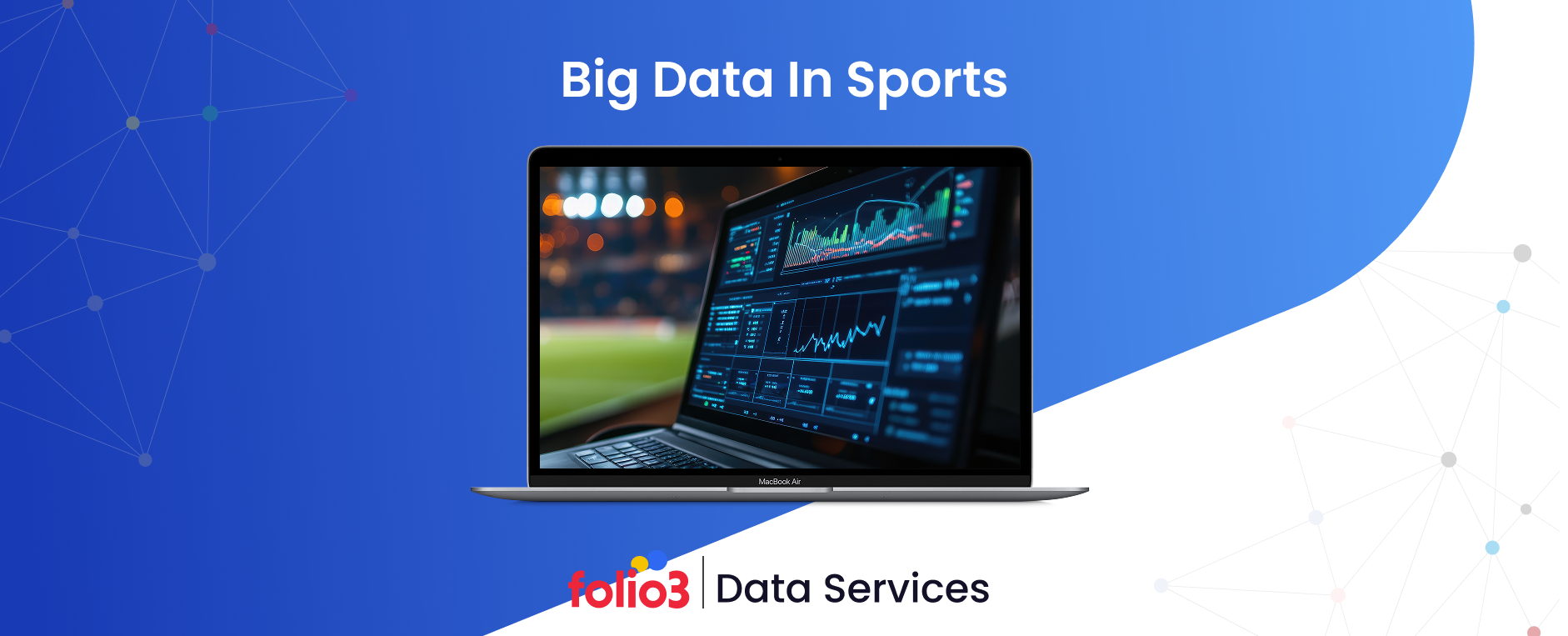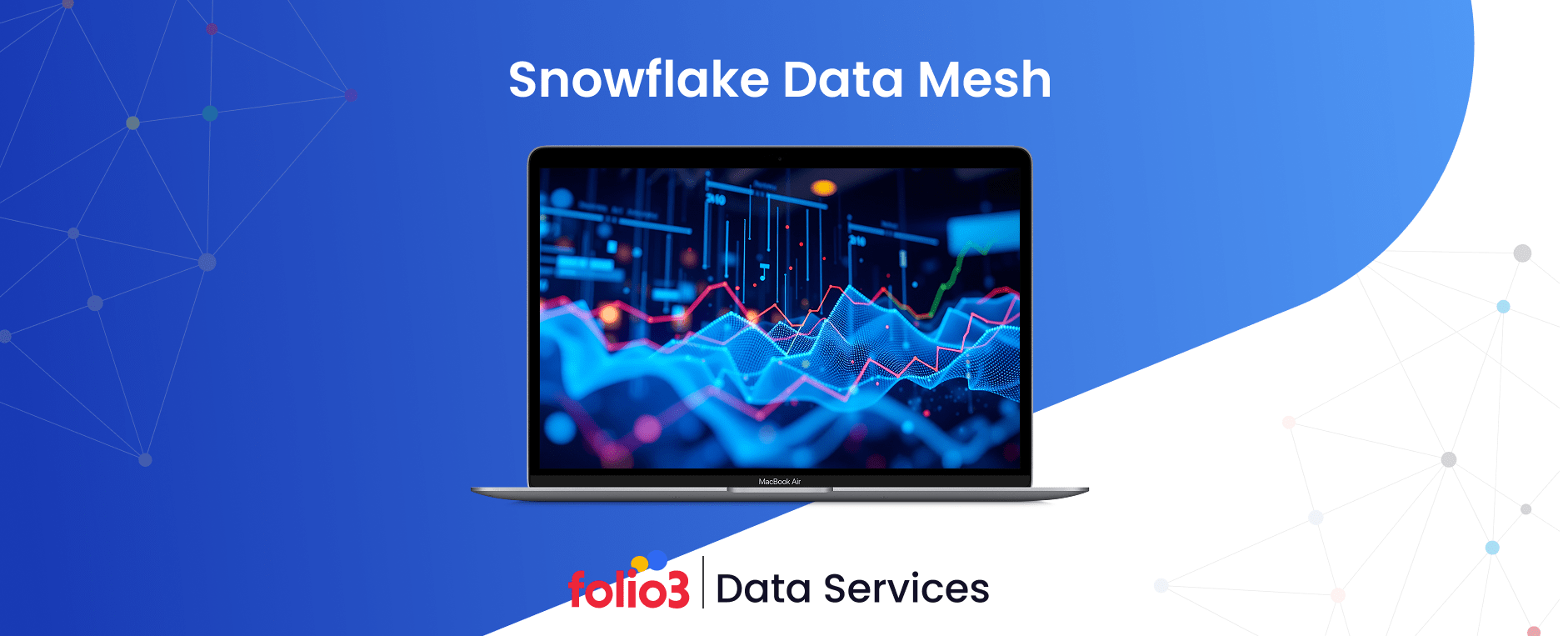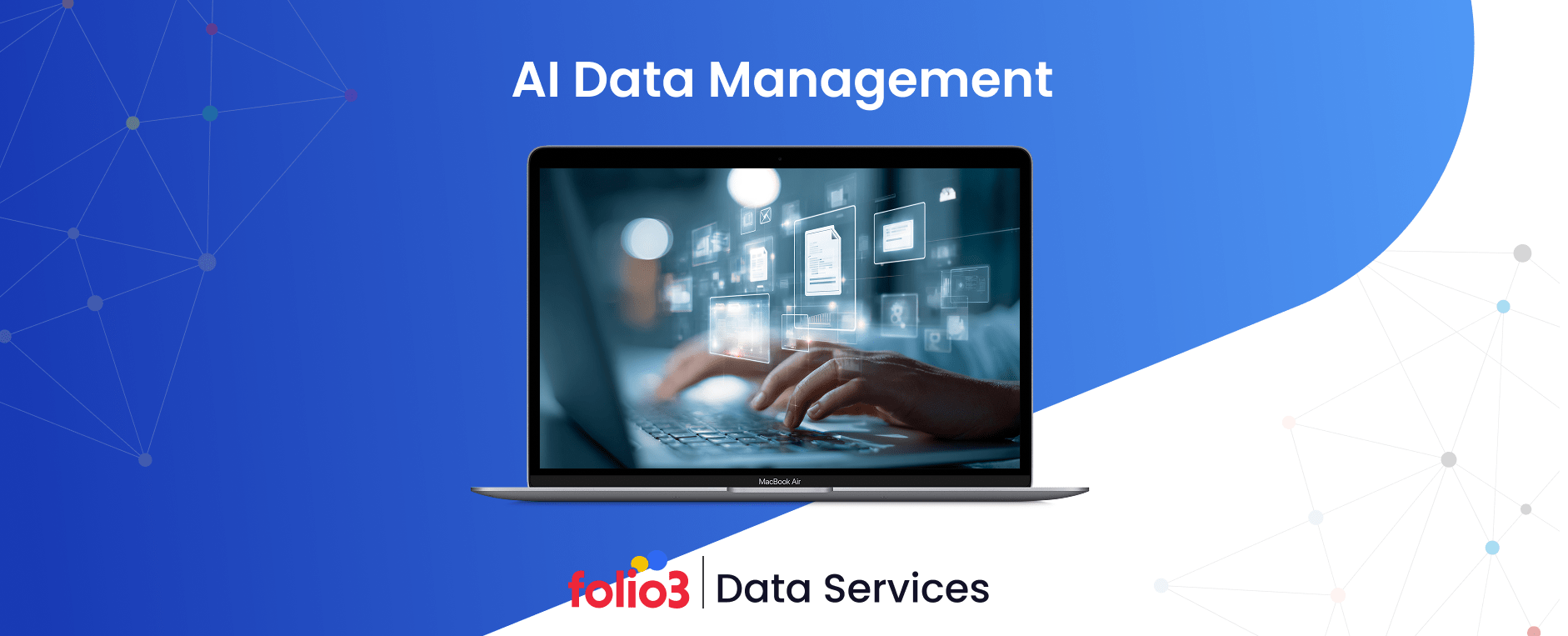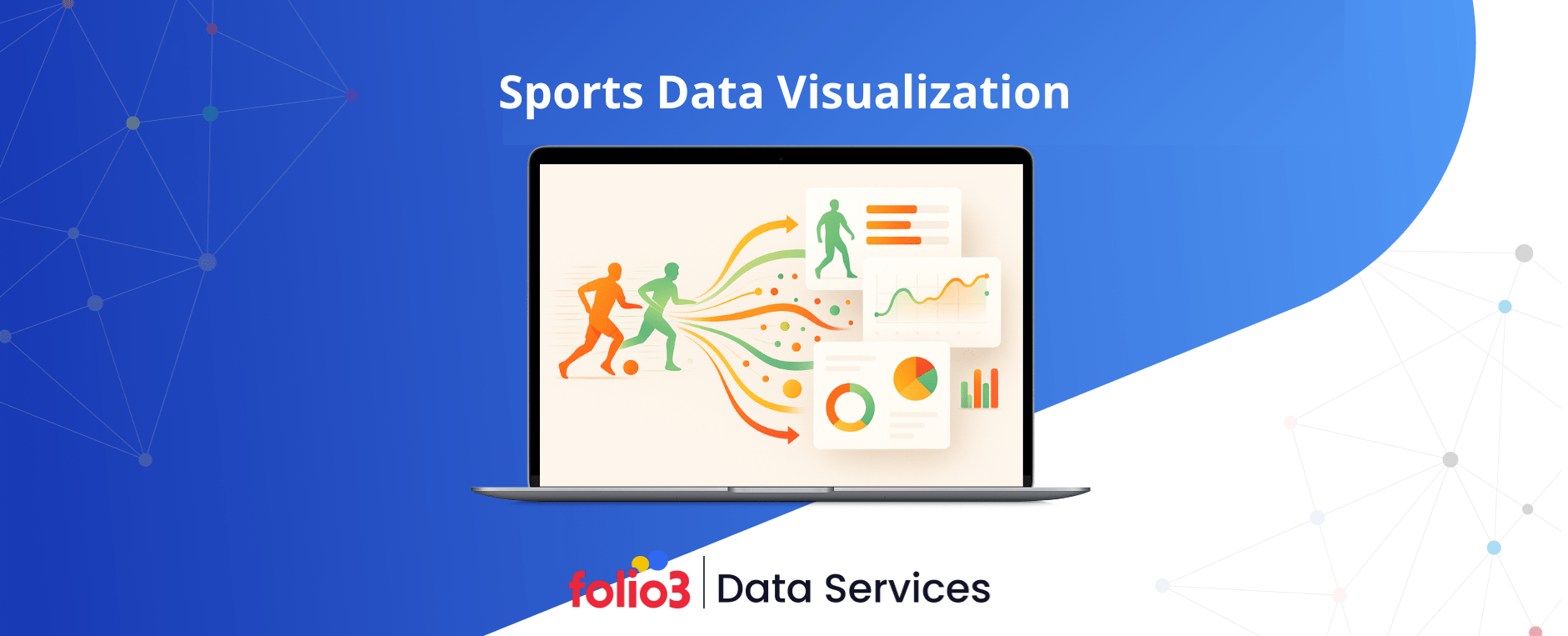There was a time when a game’s story could be told through a handful of numbers like goals, assists, rebounds, or runs scored. But that era is long gone. Today, big data in sports is rewriting the rules of how athletes train, teams compete, and fans engage. What once relied on intuition is now powered by millions of data points, algorithms, and AI-driven insights that help teams make smarter, faster, and more profitable decisions.
A single soccer match now generates terabytes of data from spatiotemporal tracking systems that monitor player movements 25 times per second, as well as from wearable sensors that capture heart rate, acceleration, and fatigue levels. This surge in big data sports analytics has allowed organisations to uncover patterns invisible to the naked eye, transforming raw numbers into winning strategies.
Take Manchester City, whose investment in analytics talent and data infrastructure gave them an edge in recruitment, tactics, and player health management. Or the Golden State Warriors, who leveraged big data analytics in sports to revolutionise shooting strategies and build a dynasty. These examples highlight the application of big data in sports, using information not as a record but as a roadmap to success.
From personalised fan engagement and big data in sports marketing to dynamic ticket pricing and sponsorship optimisation, data isn’t just supporting sports, but it’s redefining them. The playing field is no longer just about athleticism; it’s about intelligence, innovation, and insight.
What is Big Data in Sports?
Big data in sports refers to the massive, complex datasets that are continuously generated, collected, and analysed to uncover insights that traditional statistics can’t provide. These datasets are defined by the classic “three Vs” — volume, velocity, and variety.
- Volume reflects the enormous scale of data collected during games and training sessions. For example, a single NFL matchup can generate terabytes of information through wearable sensors, high-speed cameras, and biometric devices.
- Velocity represents the speed at which this information is produced and processed, which is crucial when teams need real-time sports analytics to make instant tactical adjustments.
- Variety encompasses the diversity of data sources: structured statistics, unstructured video footage, sensor readings, GPS coordinates, social media sentiment, and even fan engagement metrics.
Difference Between Traditional Stats And Big Data Sports Analytics
The difference between traditional stats and big data sports analytics lies in depth and dynamism. While conventional statistics measure outcomes, goals, assists, or runs, big data captures everything that happens between those events. It analyses how players move off the ball, how fatigue impacts decision-making, or how defensive formations adapt over time.
However, data alone holds no value without meaningful interpretation. The true power of big data analytics in sports lies in advanced statistical models, AI, and machine learning algorithms that transform raw data into actionable insights. This process demands robust data infrastructure, scalable cloud storage, automated pipelines, and interactive visualisation tools that translate complex analytics into decisions coaches and executives can act on.
Modern organisations adopting big data in sports analytics invest equally in technology and talent. Data engineers ensure data flows seamlessly from collection points to analytical systems, while data scientists and strategists interpret those findings to shape game tactics, player recruitment, and business strategies.
What Are the Core Components of Sports Big Data Systems?
The architecture powering big data in sports brings together multiple technologies and data streams that collectively shape how organizations evaluate performance, refine tactics, and enhance fan engagement. Each component plays a distinct role in transforming raw information into actionable insights that fuel both athletic and business success:
Wearable Sensor Data
At the heart of big data analytics in sports are wearable devices, GPS trackers, heart rate monitors, accelerometers, and gyroscopes that continuously collect physiological and biomechanical data during training and competition. These sensors track metrics such as distance covered, sprint speed, acceleration, and workload intensity.
Performance analysts rely on this information to optimise training loads, monitor fatigue, and detect injury risks early. When an athlete’s workload exceeds their baseline, predictive models signal potential strain or injury, enabling proactive intervention. Recovery insights from sleep-tracking devices also guide personalised conditioning programs, reinforcing the role of sports analytics data in supporting player longevity and performance.
Spatiotemporal Tracking Systems
Optical tracking cameras and radar systems record real-time player and ball movement across the field, creating millions of x-y coordinates per game. This sports big data uncovers hidden tactical insights from pressing patterns in soccer to the influence of defender proximity on shooting accuracy in basketball.
Coaches use this spatial data to refine formations, anticipate opponent behaviour, and build data-backed strategies that were once driven purely by intuition.
Real-Time Video Analysis
Through computer vision and AI, real-time video analysis systems automatically tag events such as passes, tackles, and shots. Integrated with tracking data, these platforms provide deeper tactical context, showing not just where players were, but also why specific plays succeeded or failed. This automation enables full-season analysis instead of limited game samples, dramatically improving strategic planning.
Unstructured Social Data
Beyond the field, big data in sports marketing leverages unstructured social media and fan engagement data. Using natural language processing, teams analyse fan sentiment, brand perception, and campaign performance.
These insights empower marketing and sponsorship teams to create targeted experiences, optimise campaigns, and measure ROI, completing the data-driven ecosystem that connects performance, business, and audience engagement.
How Sports Organisations Use Big Data in Decision-Making
The real power of big data in sports lies in how it drives smarter, faster, and more accurate decision-making from the field to the front office. By transforming vast datasets into actionable intelligence, teams can improve athletic performance, strengthen fan relationships, and maximise revenue potential.
Let’s explore how big data analytics in sports influences every critical area of modern sports management.
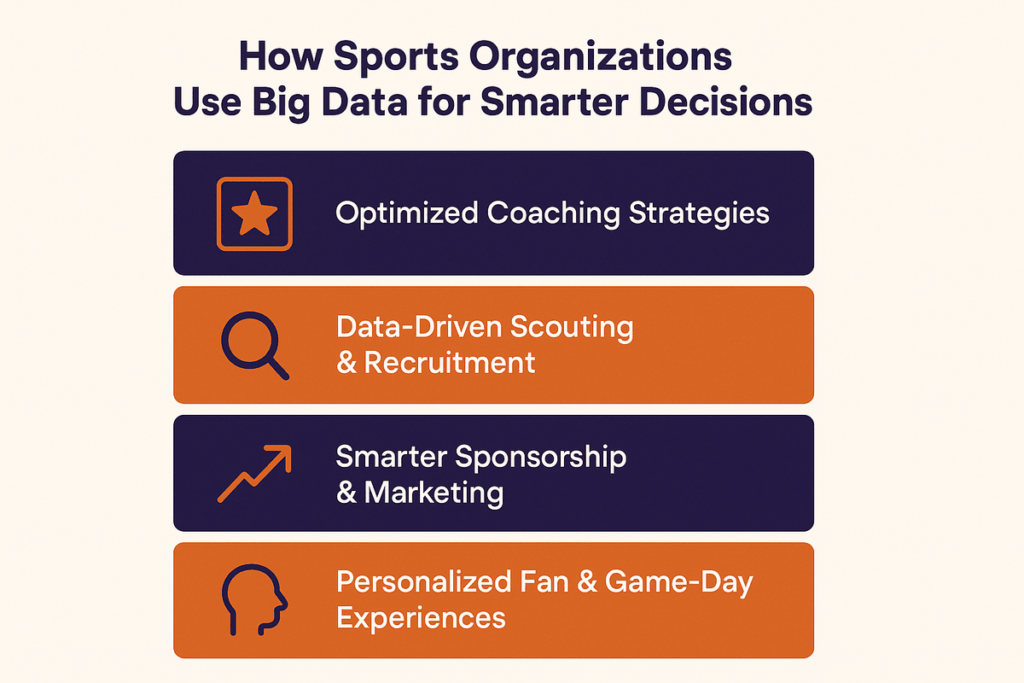
Coaching Strategy Optimisation
Gone are the days when coaching relied solely on instinct. With big data sports analytics, coaches now make evidence-based tactical decisions in real time. Advanced analytics systems detect opponent patterns during games, recommend substitutions based on fatigue or matchup advantages, and even suggest optimal play calls.
Pre-game preparations have also evolved to have teams analyse thousands of plays to uncover tendencies, such as defensive rotations or preferred formations, with statistical accuracy. Post-game, analytics tools objectively review every event, helping coaches refine strategies for future matches with data-backed insights.
Recruitment and Scouting Improvements
In player scouting, big data sports analytics has revolutionised how talent is identified and evaluated. Implementing predictive analytics in sports allows teams to assess how players will perform in new environments, adjusting for league difficulty and play style. Scouts leverage examples of big data analytics in sports, such as video analysis from international competitions, to spot undervalued talent.
Data-driven evaluations also extend beyond athletic ability, assessing injury patterns, consistency, and even social behaviour to gauge a player’s overall fit. Contract negotiations also benefit from big data, as teams use it to project future performance trends and ensure fair, strategic compensation.
Sponsorship and Marketing Analytics
Big data in sports marketing enables hyper-personalised campaigns that resonate with specific fan segments. Predictive analytics identifies at-risk fans and triggers retention strategies before disengagement occurs. Sponsorship teams leverage computer vision and sentiment analysis to measure brand exposure, engagement, and ROI precisely.
These insights empower marketing departments to optimise budgets, craft targeted messages, and strengthen brand partnerships through measurable performance outcomes.
Game-Day and Fan Experience Personalisation
Modern stadiums run on big data applications in sports that elevate the fan experience. Dynamic pricing algorithms adjust ticket rates in real time based on demand, team form, and even weather, boosting both accessibility and profitability.
Concession sales and staffing are optimised using predictive models that anticipate crowd behaviour, reducing wait times and minimising waste. Mobile integration takes personalisation further. Fans receive seat upgrades, exclusive offers, and tailored in-game content, creating immersive experiences that deepen loyalty and drive repeat attendance.
Strategic Benefits of Adopting Big Data in Sports
The adoption of big data in sports is transforming how teams, leagues, and organisations operate both on and off the field. From maximising athlete output to deepening fan loyalty, big data analytics in sports delivers measurable advantages across performance, health, engagement, and revenue.
Optimise Athlete Performance
Big data allows teams to fine-tune athlete performance at an unprecedented level. Coaches can now tailor training sessions to each player’s physiology, fatigue levels, and recovery rates rather than relying on standardised programs.
By integrating athlete monitoring technology with wearable sensor data and real-time tracking, teams gain insights into workload intensity, efficiency, and energy expenditure. This precision helps athletes perform at their peak, reduces overtraining, and ensures that every movement contributes to overall success.
Minimise Player Injury Risk
Injury prevention is one of the most impactful applications of big data in sports. Predictive analytics models assess movement patterns, workload spikes, and recovery gaps to identify athletes at higher risk of injury. When early warnings trigger intervention, such as rest adjustments or modified drills, teams protect both player health and financial investment. The result is fewer season-ending injuries, lower medical costs, and more consistent on-field performance throughout the season.
Enhance Fan Engagement
Through big data in sports marketing, organisations now craft hyper-personalised fan experiences. Data-driven insights from ticketing, social media, and app interactions allow teams to deliver targeted content, exclusive offers, and immersive in-game experiences. Fans engage more deeply when they feel understood, boosting attendance, merchandise sales, and digital engagement metrics.
Drive Better Revenue
Financial performance also benefits significantly from big data analytics in sports. Dynamic pricing strategies adjust ticket prices in response to real-time demand, maximising revenue potential. Marketing teams use predictive analytics to refine campaigns and increase conversion rates, while sponsorship valuation models demonstrate clear ROI to partners. Together, these data-driven strategies enhance profitability and ensure long-term business sustainability.
Empower your team with advanced analytics, predictive modeling, & cloud-based systems designed by Folio3’s data experts.
Real-World Examples of Big Data in Sports
The following case studies showcase how big data in sports is more than a buzzword. it’s driving real outcomes across performance, tactics, recruitment, and fan engagement.
Football (Soccer) – Liverpool FC
Liverpool FC leveraged big data sports analytics to redefine its recruitment and tactical strategy. By developing models such as “possession value,” the club quantified how each player’s touch contributed to goal-scoring chances. Their data-driven recruitment of undervalued players like Mo Salah and Sadio Mané highlighted the examples of big data analytics in sports, where player attributes fit the system rather than the market price.
Basketball – Golden State Warriors and the NBA
The NBA’s three-point revolution illustrates the power of big data analytics in sports. Research shows how teams shifted to higher-value shots beyond the arc, supported by detailed shot-location data and regression models. The Warriors’ success is linked to their embrace of these insights, making big data in sports central to both strategy and lineup decisions.
Cricket – Hawk‑Eye Innovations Tracking
Cricket analytics via Hawk-Eye systems represent the application of big data in sports by tracking ball trajectory, spin, and player movement. Teams now use these data streams to tailor bowling plans, optimise field placements, and develop batting strategies based on precise measurements of every delivery.
Baseball – The “Moneyball” Model
Baseball’s analytic origins highlight the evolution of big data sports analytics. The “Moneyball” approach, using statistical metrics to identify undervalued talent, changed the game for teams operating with limited budgets. While this story is less cited in modern online case studies, it remains the foundational example of big data in sports driving competitive advantage.
Esports
In esports, perfect logging of virtually every action provides a playground for big data in sports analytics and predictive modelling. Teams analyse player performance, strategic choices, and fan behaviour using tools that rival those of physical-sport systems in depth and granularity.
The Impact of Big Data on Sports Performance and Strategy
The use of big data in sports has revolutionised how teams plan, compete, and engage with fans. Whether it’s making split-second tactical decisions, improving player recruitment accuracy, or predicting injuries before they happen, sports analytics has become central to modern athletic success.
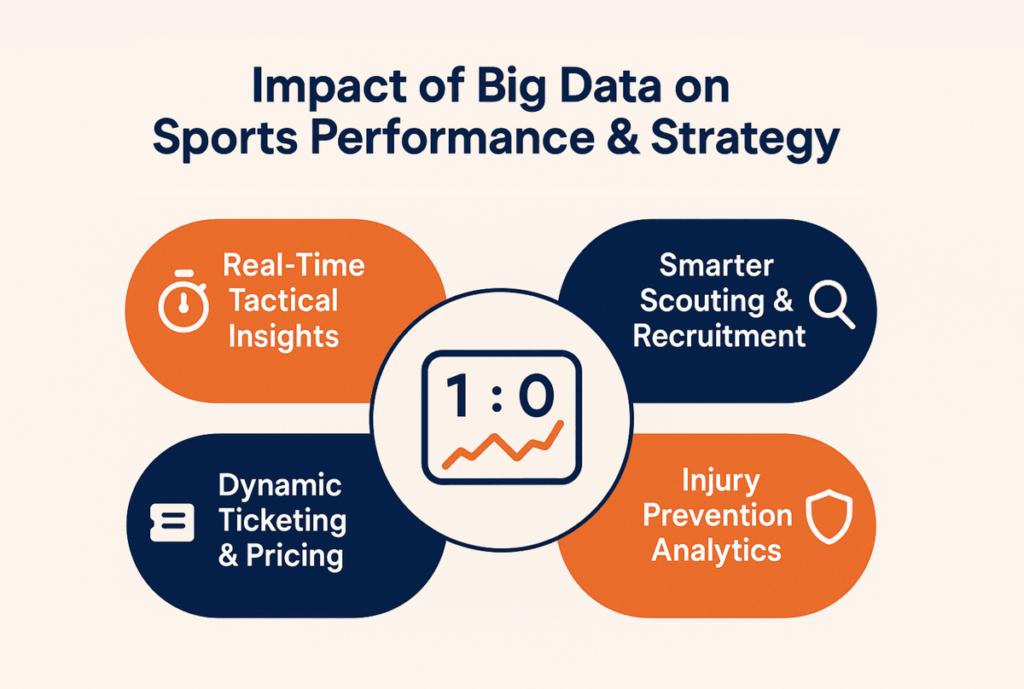
Real-Time Tactical Decisions
Real-time analytics empower coaches and teams to make smarter, faster decisions during live games. Through wearable sensors, GPS trackers, and advanced video analytics, coaches receive instant updates on player positioning, stamina, and tactical execution.
This allows them to adapt strategies mid-game, such as modifying formations, adjusting player matchups, or exploiting opponent weaknesses. For instance, football managers and NBA coaches use real-time sports data to decide substitutions and rotations based on fatigue or performance trends, rather than relying solely on intuition.
Player Scouting and Recruitment
Gone are the days of relying purely on gut instinct for player selection. Big data analytics in sports has transformed scouting into a precise, evidence-based process. Teams now analyse vast datasets covering performance metrics, psychological profiles, and contextual game factors.
Predictive modelling helps clubs like Liverpool FC or NBA teams identify undervalued players who fit specific tactical roles. This data-driven recruitment not only improves roster construction but also reduces costly transfer mistakes by aligning signings with long-term strategic goals.
Injury Prevention Analytics
Injury analytics powered by big data help teams protect their most valuable assets, the athletes. By tracking workload, biomechanics, and recovery cycles, predictive systems flag early signs of stress or imbalance before injuries occur.
AI-based performance monitoring tools can identify fatigue trends and suggest personalised recovery programs, reducing soft-tissue injuries by up to 30%. This proactive approach enhances both player longevity and overall team performance.
Dynamic Ticketing and Pricing
Beyond the field, big data in sports business is driving more innovative financial strategies. Dynamic ticketing models use predictive analytics to adjust prices based on factors like demand, team performance, opponent popularity, and even weather conditions.
This ensures optimal revenue capture during high-demand events while keeping prices accessible for regular games. Many professional leagues report 10–20% higher ticket revenue using these data-driven pricing systems, demonstrating how analytics optimise both fan experience and profitability.
Big Data in Sports vs. Traditional Statistics: A Detailed Comparison
The shift from traditional sports statistics to big data analytics in sports represents a fundamental transformation in how teams evaluate performance, make decisions, and strategise. While conventional statistics rely on simple historical records and averages, big data leverages advanced technologies, machine learning, and real-time data streams to provide predictive and actionable insights. The table below highlights the key differences between the two approaches.
| Aspect | Traditional Sports Statistics | Big Data in Sports Analytics |
| Data Volume and Speed | Limited to manually collected, small datasets such as box scores, goals, assists, and averages. Data is processed slowly and retrospectively. | Involves massive, continuous data streams from sensors, wearables, video analytics, and IoT devices. Data is collected, processed, and analysed in real time. |
| Descriptive vs. Predictive Focus | Primarily descriptive focuses on what happened in the past (e.g., batting average, shot percentage, or goals scored). | Predictive and prescriptive — uses historical and live data to forecast outcomes like injury risk, player fatigue, or game-winning probabilities. |
| Post-Game vs. Real-Time Analysis | Analysis usually occurs after the game, providing insights for review sessions or media reports. | Provides real-time insights during gameplay, enabling coaches to make immediate tactical adjustments or substitutions based on data feedback. |
| Holistic Data Perspective | Focuses mainly on individual or team statistics without context (e.g., player scores or win-loss ratios). | Takes a 360-degree view by combining physiological, tactical, psychological, and environmental data for a comprehensive performance profile. |
| Decision-Making Impact | Decisions are intuition-driven mainly, guided by experience and limited data. | Decisions are data-driven, blending AI models, predictive analytics, and contextual insights to deliver measurable strategic advantage. |
Key Challenges and Ethical Risks for Sports Data
While big data analytics in sports delivers remarkable benefits, its implementation also brings complex challenges and ethical dilemmas. To ensure sustainable and responsible use, sports organisations must address key issues related to data privacy, quality, cost, and cultural adoption.
Athlete Data Privacy
As the use of biometric sensors, GPS trackers, and wearables becomes standard, athlete data privacy has emerged as a pressing concern. These devices collect sensitive information from heart rate and fatigue levels to mental health indicators.
Without proper safeguards, this data could be misused during contract negotiations or exposed through cyberattacks. Regulations such as GDPR and CCPA require sports organisations to obtain explicit consent, ensure the secure storage of athlete data, and maintain transparency about how athlete data is collected and used. Ethical data governance is no longer optional but it’s a competitive necessity.
Data Quality and Veracity
For sports data analytics to produce reliable insights, accuracy and consistency are crucial. Sensor malfunctions, manual entry errors, and incompatible data formats can all compromise analysis.
Poor-quality data can lead to flawed performance predictions or incorrect injury assessments. Teams are investing in data validation pipelines and standardised formats to ensure integrity and minimise errors that could impact critical game-day decisions.
High Technology Costs
The cost of implementing big data in sports remains a significant hurdle for smaller organisations. Advanced tracking systems, AI-driven analytics platforms, and cloud infrastructure require substantial financial investment. While elite clubs can afford these tools, smaller teams risk falling behind, widening the digital divide in competitive sports.
Cultural Adoption Resistance
Even with the right technology, success depends on cultural acceptance. Many coaches and scouts still rely on intuition and experience, viewing analytics as a threat rather than a complement. Building trust through education and demonstrating tangible results helps bridge this gap, fostering collaboration between data scientists and traditional decision-makers.
Proven Strategies for Successful Sports Analytics Implementation
To fully use the power of data in sports, organisations need more than just advanced technology. They need a well-defined big data implementation strategy that connects analytics with real-world performance and business goals. The following methods have proven most effective in ensuring long-term success.
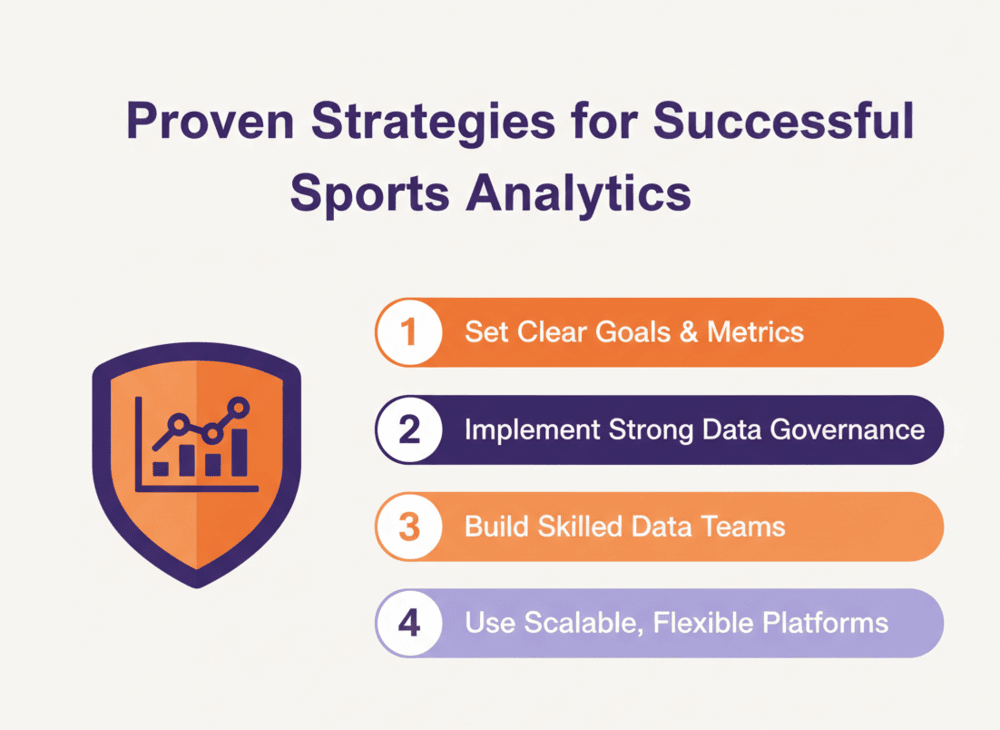
Define Clear Metrics and Objectives
Successful sports analytics implementation begins with setting measurable and outcome-oriented goals. Instead of vague ambitions like “improve performance,” teams should define specific, quantifiable objectives such as reducing injury rates by 20%, increasing ticket revenue by 15%, or optimising player workloads.
Clear KPIs focus analytics efforts on initiatives that directly impact organisational success. Early wins tied to these goals help build credibility and strengthen internal support for data-driven decision-making.
Establish Strong Data Governance
Without a robust data governance framework, even the most advanced systems can fail. Governance ensures consistency, security, and ethical compliance by defining how data is collected, stored, and shared. It also specifies ownership, access rights, and maintenance responsibilities.
Adhering to these standards prevents data silos, enhances collaboration across departments, and mitigates privacy and regulatory compliance risks, which are critical in sports where athlete information is highly sensitive.
Invest in Skilled Data Talent
The real value of sports big data analytics lies in those who can interpret it effectively. Building cross-functional teams that include data scientists, performance analysts, coaches, and scouts bridges the gap between raw data and actionable insights.
This collaboration enables a deeper understanding of player performance, opponent analysis, and injury risk modelling, ensuring data insights are both technically sound and practically relevant.
Choose Scalable and Flexible Platforms
As data volume and complexity grow, scalability becomes essential. Cloud-based analytics platforms offer flexible storage and processing capabilities, enabling organisations to scale without incurring significant infrastructure costs.
Modular systems enable the easy integration of new technologies, wearables, and analytics tools, ensuring long-term adaptability in a rapidly evolving sports data ecosystem.
How Folio3 Enables Big Data in Sports Success?
In today’s fast-evolving sports landscape, big data analytics has become the cornerstone of competitive success in driving more innovative strategies, enhanced athlete performance, and deeper fan engagement.
At Folio3 Data Services, we empower sports organisations to harness this potential through end-to-end data engineering and predictive analytics solutions that are scalable, fast, and precise.
Build Custom Data Architecture
Every successful analytics strategy begins with a solid foundation. Folio3 designs custom big data architectures that unify data from multiple sources, including sensors, wearables, video feeds, and performance databases.
Our experts ensure seamless data integration and transformation, enabling teams to access reliable, real-time insights. Whether you’re tracking athlete biometrics or fan engagement metrics, our architectures are built for high availability and future scalability.
Develop AI/ML Models
Folio3’s AI and machine learning model development turns raw data into predictive power. We build custom sports analytics solutions and predictive models that help forecast player performance, injury risk, and game outcomes. By analysing historical trends and live game data, our models enable data-driven decision-making that enhances tactical precision and recruitment efficiency, making it a true game-changer for modern sports organisations.
Implement Real-Time Pipelines
Speed is everything in competitive sports. Our real-time data pipelines ensure that decision-makers receive instant insights. Whether it’s tracking fatigue levels mid-game or adjusting pricing dynamically for high-demand matches. Leveraging cloud platforms like AWS, Snowflake, and Databricks, we deliver scalable, low-latency solutions that keep your analytics always a step ahead.
Ensure Secure Data Governance
With the growing volume of sensitive athlete and organisational data, secure data governance is non-negotiable. Folio3 implements comprehensive governance frameworks that protect data integrity, ensure regulatory compliance, and maintain ethical use. From GDPR alignment to access control, we safeguard every layer of your data ecosystem.
From injury prevention to fan engagement, Folio3’s data solutions help you make faster, smarter, & more impactful decisions.
The Future Trends in Sports Analytics and Big Data
The future of big data in sports is unfolding at the intersection of technology, AI, and human performance. As data ecosystems mature, organisations are moving beyond basic analytics toward predictive, adaptive, and immersive systems that redefine competition and fan interaction. Here are four transformative trends shaping the next decade of sports data analytics.
Hyper-Personalized Wearables
The next generation of sports wearables will go far beyond tracking heart rate and distance. Using AI-powered biometric sensors, athletes will receive real-time insights into hydration levels, muscle fatigue, and mental readiness.
These hyper-personalised wearables will provide continuous feedback, allowing coaches to make immediate adjustments to training loads and recovery plans. By integrating with big-data platforms, teams can predict performance peaks, prevent overtraining, and extend athletes’ longevity.
Digital Twin Simulation
A significant innovation in sports big data analytics is the rise of digital twins, virtual replicas of athletes, teams, or even entire games. By combining historical data, biomechanics, and environmental conditions, teams can simulate match scenarios, test tactical variations, and optimise strategies before game day. Digital twins also allow medical staff to experiment with rehab protocols in a risk-free virtual environment, accelerating safe returns to play.
Immersive Fan Experiences
The fan experience will evolve through immersive technologies like augmented reality (AR), virtual reality (VR), and AI-driven personalisation. Using big data in sports marketing, organisations can tailor experiences to individual fan preferences from real-time stat overlays in AR to personalised merchandise suggestions based on behaviour data. This level of customisation not only boosts engagement but also drives higher conversion and loyalty rates.
Automated Scouting AI
AI-driven scouting systems are revolutionising talent identification by processing millions of data points from global competitions. Advanced computer vision, AI based data extraction software, and machine learning algorithms analyse video footage to evaluate movement patterns, technical ability, and tactical intelligence.
Combined with predictive modelling, automated scouting AI helps identify undervalued prospects earlier and reduces human bias in player evaluation, enabling smarter, data-backed recruitment strategies.
FAQs
How does big data directly improve player performance analytics?
Big data in sports enhances player performance by analysing sensor and wearable data to track fatigue, workload, and recovery. Coaches use these insights to customise training and improve endurance, speed, and efficiency.
How do sports teams use data analytics to gain a competitive edge?
Teams use sports data analytics to identify tactical advantages, optimise lineups, and analyse opponent strategies. Real-time insights help improve decision-making and overall game performance.
What is the role of predictive analytics in injury prevention?
Predictive analytics forecasts injury risks by analysing workload, biomechanics, and recovery patterns. This allows teams to adjust training proactively and reduce athlete downtime.
Which AI tools are essential for modern sports recruitment?
AI tools like computer vision, predictive modelling, and machine learning evaluate player performance and potential. These technologies enable data-driven recruitment and eliminate bias in scouting.
What are the biggest challenges in sports data collection?
Challenges include maintaining data accuracy, managing privacy concerns, and handling high technology costs. Effective governance and scalable infrastructure help overcome these issues in sports analytics.
How does data enhance the fan engagement experience?
Sports data analytics enables personalised fan experiences through targeted offers, dynamic pricing, and immersive digital engagement. This boosts loyalty and drives higher fan satisfaction.
Why is real-time data crucial for live game analysis?
Real-time sports analytics allows teams to monitor player performance and make instant tactical adjustments. It transforms coaching decisions from reactive to data-driven.
When did big data first influence team coaching decisions?
Big data in sports gained traction in the early 2000s during baseball’s “Moneyball” era. Today, all major leagues use analytics to develop more effective coaching and game strategies.
What is predictive modeling in modern sports betting?
Predictive modeling uses big data to forecast match outcomes and player performance. Machine learning continuously refines these predictions for more accurate betting insights.
How can data monetisation increase sports team revenue?
Teams leverage sports data monetisation to personalise marketing, optimise ticket pricing, and attract targeted sponsorships, turning analytics into new revenue streams.
Conclusion
Big data has revolutionised the sports industry, shifting it from instinct-based decisions to evidence-driven strategies that optimise performance, operations, and fan engagement. As predictive analytics, AI, and real-time data evolve, the competitive edge will increasingly favour data-savvy organisations.
To fully unlock the power of sports analytics, partnering with experts like Folio3 Data Services can help teams implement scalable data solutions, managed analytics processes, and transform raw insights into winning strategies both on and off the field.
